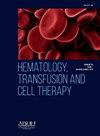PROGRESSION OF POLYCYTHEMIA VERA TO ACUTE MYELOID LEUKEMIA FOLLOWING LONG-TERM HYDROXYUREA THERAPY: A CASE STUDY
IF 1.6
Q3 HEMATOLOGY
引用次数: 0
Abstract
Polycythemia Vera (PV) is a chronic Myeloproliferative Neoplasm (MPN) with a well-documented risk of progression to Aute Myeloid Leukemia (AML), particularly in patients undergoing prolonged cytoreductive therapy. This report details the case of a 66-year-old male diagnosed with PV five years prior, initially managed with hydroxyurea. Over time, he developed progressive pancytopenia, ultimately leading to a diagnosis of AML. Following leukemic transformation, the patient was treated with azacitidine, a hypomethylating agent commonly utilized in myeloid malignancies. However, hematologic response was minimal, and disease progression ensued. Molecular analysis identified AML-associated mutations, which are implicated in disease evolution, therapeutic resistance, and poor prognosis. The transition from PV to AML represents a critical clinical challenge, significantly worsening patient outcomes. While hydroxyurea remains a widely used first-line therapy for PV, its potential role in leukemic transformation continues to be debated. Azacitidine, although a viable therapeutic option for post-MPN AML, frequently yields limited and non-durable responses, particularly in patients with high-risk genetic alterations. This case underscores the necessity of vigilant monitoring in PV patients receiving long-term cytoreductive therapy to enable early detection of leukemic progression. Alternative treatment approaches, including JAK inhibitors, interferon therapy, and early hematopoietic stem cell transplantation in eligible patients, may play a role in reducing leukemic transformation risk. Further research is essential to enhance the understanding of post-MPN AML pathogenesis and optimize treatment strategies to improve patient survival.
真性红细胞增多症在长期羟基脲治疗后进展为急性髓性白血病:一个病例研究
真性红细胞增多症(PV)是一种慢性骨髓增生性肿瘤(MPN),有进展为急性髓系白血病(AML)的风险,特别是在接受长期细胞减少治疗的患者中。本报告详细介绍了一名66岁男性五年前诊断为PV,最初用羟基脲治疗的病例。随着时间的推移,他出现了进行性全血细胞减少症,最终被诊断为急性髓性白血病。白血病转化后,患者接受阿扎胞苷治疗,阿扎胞苷是一种通常用于髓系恶性肿瘤的低甲基化药物。然而,血液学反应很小,随后疾病进展。分子分析确定了aml相关突变,这些突变与疾病演变、治疗耐药性和预后不良有关。从PV到AML的转变是一个关键的临床挑战,显著恶化了患者的预后。虽然羟基脲仍然是PV广泛使用的一线治疗药物,但其在白血病转化中的潜在作用仍存在争议。阿扎胞苷虽然是mpn后AML的可行治疗选择,但通常产生有限和非持久的反应,特别是在高风险遗传改变的患者中。该病例强调了对接受长期细胞减少治疗的PV患者进行警惕监测的必要性,以便早期发现白血病进展。替代治疗方法,包括JAK抑制剂、干扰素治疗和符合条件的患者的早期造血干细胞移植,可能在降低白血病转化风险方面发挥作用。进一步的研究对于提高对mpn后AML发病机制的理解和优化治疗策略以提高患者生存率至关重要。
本文章由计算机程序翻译,如有差异,请以英文原文为准。
求助全文
约1分钟内获得全文
求助全文
来源期刊

Hematology, Transfusion and Cell Therapy
Multiple-
CiteScore
2.40
自引率
4.80%
发文量
1419
审稿时长
30 weeks
 求助内容:
求助内容: 应助结果提醒方式:
应助结果提醒方式:


